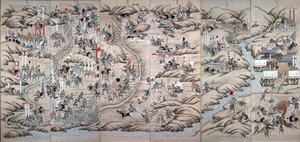| Battle of Nagashino | |||||||
|---|---|---|---|---|---|---|---|
| Part of the Feudal Japan | |||||||
 Battle of Nagashino pictured on a Byōbu screen | |||||||
| |||||||
| Belligerents | |||||||
|
Oda clan Tokugawa clan | Takeda clan | ||||||
| Commanders and leaders | |||||||
|
Oda Nobunaga Tokugawa Ieyasu Imagawa Ujizane Okudaira Sadamasa Akechi Mitsuhide[1] Sassa Narimasa Honda Tadakatsu Ikeda Tsuneoki Hashiba Hideyoshi Matsudaira Ietada Niwa Nagahide Ōkubo Tadayo Maeda Toshiie Sakuma Nobumori Kanamori Nagachika Matsudaira Nobuyasu Ishikawa Kazumasa Takigawa Kazumasu Ōkubo Tadachika Shibata Katsuie Oda Nobutada Sakai Tadatsugu Sakakibara Yasumasa Watanabe Moritsuna Matsudaira Koretada † |
Takeda Katsuyori Ichijō Nobutatsu Anayama Nobutada Oyamada Nobushige Yamagata Masakage † Naitō Masatoyo † Baba Nobufusa † Sanada Nobutsuna † Takeda Nobuzane † Tsuchiya Masatsugu † Obata Masamori Sanada Masateru † Hara Masatane † Takeda Nobukado Sanada Masayuki Saegusa Moritomo † Takeda Nobutoyo Kōsaka Masanobu | ||||||
| Strength | |||||||
| 38,000–72,000[2] | 15,000–20,000[2] | ||||||
| Casualties and losses | |||||||
| 6,000 killed | 10,000 killed | ||||||
The Battle of Nagashino (長篠の戦い, Nagashino no Tatakai) was a famous battle in Japanese history, fought in 1575 at Nagashino in Mikawa Province (present-day Nagashino, Shinshiro, Aichi Prefecture). The allied forces of Oda Nobunaga and Tokugawa Ieyasu (38,000) fought against Takeda Katsuyori's forces (15,000) and the allied forces won a crushing victory over the Takeda clan. As a result, Oda Nobunaga's unification of Japan was seen as certain.[3][4]
In recent years, the battle has increasingly been referred to as the Battle of Nagashino and Shitaragahara (長篠・設楽原の戦い, Nagashino Shitaragahara no Tatakai). The battle started with an offensive over Nagashino Castle, followed by a battle at Shitaragahara, about 4 km to the west of the castle. Traditionally, the siege of Nagashino Castle by the Takeda forces and the decisive battle between the two main armies were regarded as a series of manoeuvres, and the battle was called the "Battle of Nagashino" after Nagashino, the name of a wide area in the region. However, if the emphasis is on the actual location of the battle (where the final battle took place), it is more appropriate to use "Battle of Shitara-gahara". Therefore, both place names are now listed together.[5][6]
The battle is often cited as a turning point in Japanese warfare and as the first "modern" battle in Japan, as it was the battle in which Oda Nobunaga defeated the cavalry of the Takeda army with his powerful arquebusiers, using tanegashima.[7][8]
The causes of victory for the allied forces used to be cited as the horse defensive fence (stockade) that prevented the advance of the Takeda cavalry, the three-stage shooting of 3,000 guns that fired in rapid succession in shifts of 1,000 guns each, and Katsuyori's reckless orders for a charge. However, recent research has led to the theory that the real cause of victory was something else.[a][3][8] However, there is no doubt that matchlock guns played an active role, including in the sniping death of Yamagata Masakage, who was a famous general in the Takeda Army.[4]
- ^ Hayashima 2016, p. 178.
- ^ a b Tokugawa jikki.
- ^ a b Ishikawa, Takuji (13 August 2009). "長篠・設楽原:下 揺らぐ「三段撃ち」説" [Nagashino and Shitahara: part 2 – the wavering 'three-stage shooting' theory]. Asahi Shimbun Digital (in Japanese). Retrieved 18 October 2023.
- ^ a b Takeda, Kyoson (7 July 2015). "梅雨が変えた戦国の歴史 「信長戦記」に新たな視点" [History of the Sengoku period changed by the rainy season: A new perspective on Nobunaga Senki]. Nikkei Style (in Japanese). The Nikkei. Retrieved 18 October 2023.
- ^ Ishikawa, Takuji (11 August 2009). "長篠・設楽原:上 忠義の兵、影に地元武士" [Nagashino and Shitahara: Part 1 – Loyal soldiers, local samurai in the shadows]. Asahi Shimbun Digital (in Japanese). Retrieved 18 October 2023.
- ^ Nishimata, Fusao (21 June 2023). "織田・徳川連合軍と武田の戦い「長篠合戦」「設楽原合戦」どちらが正しい?" [Battle between Oda and Tokugawa allied forces and Takeda: Which is correct, the Battle of Nagashino or the Battle of Shitaragahara?]. JBpress (in Japanese). Japan Business Press Co., Ltd. Retrieved 18 October 2023.
- ^ Nishimata, Fusao (20 October 2020). "長篠合戦の主役は織田軍の鉄砲隊ではなかった? 長篠合戦の真実・前編" [Didn't the Oda army's gun corps play a leading role in the Battle of Nagashino? The truth about the Battle of Nagashino: Part 1]. JBpress (in Japanese). Japan Business Press Co., Ltd. Retrieved 18 October 2023.
- ^ a b Honda, Taikashige (3 June 2023). "長篠の戦い「前日」に信長が仕掛け、その勝敗を分けた「ある策」とは? 有名な「三段撃ち」はあったのか? 長篠城をめぐる合戦の真実" [What "certain measures" did Nobunaga implement "the day before" the Battle of Nagashino that determined the outcome? Was the famous 'three-stage shooting' executed? The truth about the battle of Nagashino Castle.]. Fujin Kōron (in Japanese). Chuokoron-Shinsha. Retrieved 18 October 2023.
Cite error: There are <ref group=lower-alpha> tags or {{efn}} templates on this page, but the references will not show without a {{reflist|group=lower-alpha}} template or {{notelist}} template (see the help page).